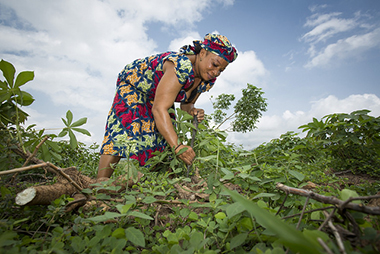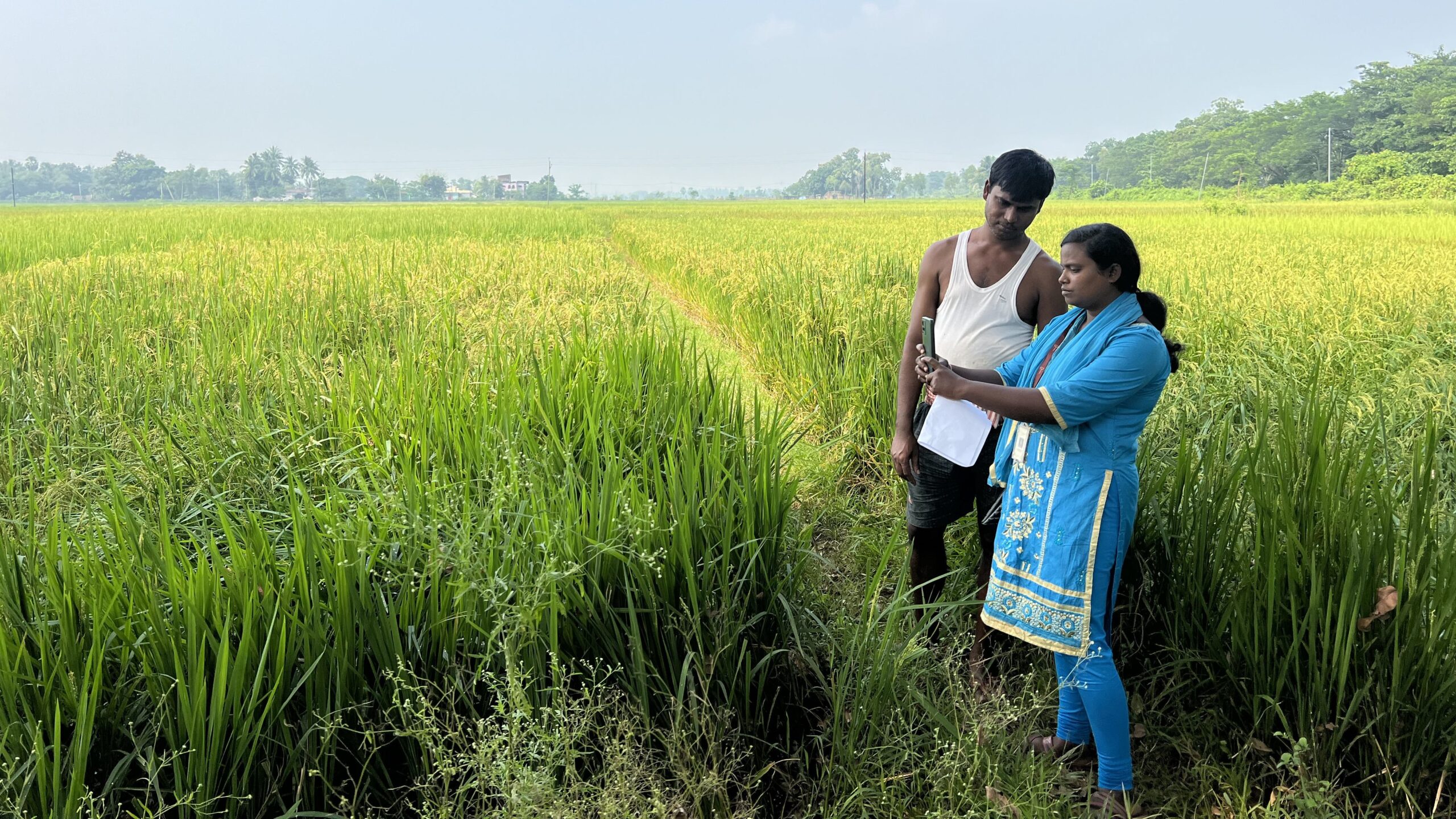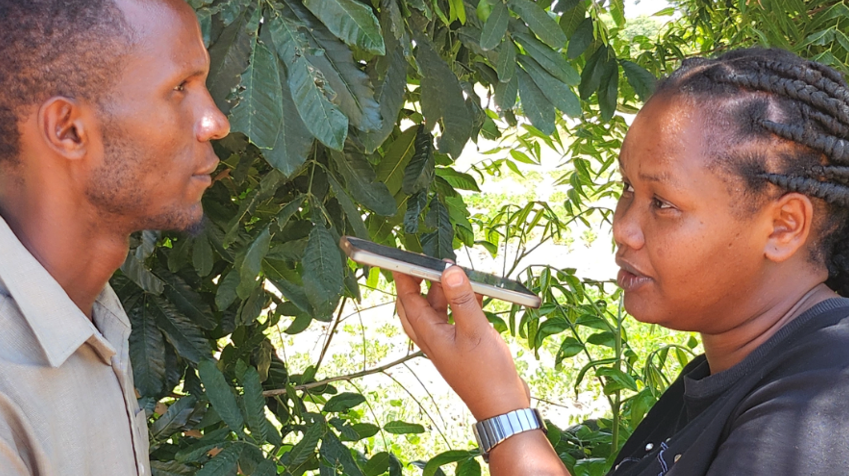The following blog by IFPRI gender experts Sophie Theis, Agnes Quisumbing, and Ruth Meinzen-Dick is the second in a four-part series leading up to the Policy Seminar on “Beijing +20 and Beyond: How Gender Research Is Changing the Landscape of Food Policy,” to be held on October 14, 2015 at IFPRI’s Washington, DC headquarters.
To commemorate Beijing+20, we are taking stock of research at IFPRI over the past 20 years that contributed to advancing gender equality by generating evidence from action, and compelling action from the evidence produced.
This blog post, part two in a four-part series on IFPRI gender research in the past 20 years, shares key takeaways from research on themes of:
- closing gender gaps in agricultural productivity
- access, control, and ownership of assets
- land rights
- legal institutions and governance
Tune in to the next post in the blog series to read highlights from IFPRI gender research related to social capital, sustainability, and health. See full list of publications (PDF 94K). Then join us on October 14th for an IFPRI policy seminar celebrating Beijing+20.
Most of the articles shared in this series are published in peer-reviewed journals, but the hyperlinks provided go to the open access versions of the publications, except where noted with an asterisk.
Closing gender gaps in agriculture:
- Women play important and varied roles in agriculture, but they are constrained by two important types of gender gaps: women have unequal access, relative to men, to productive resources, and there is insufficient information about the roles and resources of women and men. Closing these gender gaps would be good both for women and for agriculture (eds Quisumbing et al 2014).
- In a critical review of recent efforts to increase poor female farmers’ access to and control over productive resources, Quisumbing and Pandolfelli (2010) identify key strategies to address gender-based constraints in accessing productive resources and highlight promising approaches tested in the field.
- Peterman et al (2011) investigate the puzzle of gender differences in agricultural productivity in Nigeria and Uganda and find persistent lower productivity on female-owned plots and among female-headed households. However, results depend on aggregation of gender indicator, crop-specific samples, agro-ecological zone and biophysical characteristics, which point to need for better data to unpack productivity gaps.
- Evidence from a review of micro-level studies on gender differences in access, adoption and use of non-land agricultural inputs globally in the last 10 years indicates that among technological, natural and human resources, women are consistently disadvantaged (Peterman et al (2015).
- In Ethiopia, production models did not show significance of access to extension services in affecting farm productivity, but it is the perceived usefulness of those services that statistically explains variation in farm productivity of both female and male heads of households. Quality extension service is significant in explaining female household heads’ productivity in barley, fruits and vegetables production and in explaining male heads’ productivity in teff, maize, enset and permanent crops (Ragasa et al 2013).
- Women farmers are more receptive to women communicators. Training and leveraging key women in the community is more likely to lead other women to adopt conservation agriculture than training key men in the community to transfer their knowledge (Klondylis et al 2014)
- Addressing gender in agricultural research requires moving beyond a focus on productivity, toward a broader view of agricultural and food systems that recognizes women’s priorities and distinct role in ensuring the food security of their households (Meinzen-Dick et al 2011).
- The implementation modality of agricultural interventions also matters: agricultural interventions disseminated through women’s groups in Bangladesh did better in the long-run to build women’s assets and improve women’s and children’ nutrition than those interventions targeted to households, and by default, men, even if income gains were larger in the household-targeted interventions (Kumar and Quisumbing, 2011; Quisumbing and Kumar, 2011)
Access, control, and ownership of assets:
- Being able to access, control, and own productive assets such as land, labor, finance, and social capital enables people to create stable and productive lives. For researchers and program implementers, Meinzen-Dick et al (2011) offer a conceptual framework to understand the gendered pathways through which asset accumulation occurs, including attention to not only men’s and women’s assets but also those they share in joint control and ownership.
- Results from eight studies across seven countries in South Asia and sub-Saharan Africa as part of the Gender, Assets, and Agriculture Project (GAAP) show that it is necessary to consider the gender dynamics related to individual and household assets when designing, implementing, and evaluating agricultural development projects (Johnson et al 2015; Quisumbing et al. 2013; Quisumbing et al 2015). The GAAP technical guide provides guidance on qualitative and quantitative tools to help researchers collect data and design and monitor projects to address the gender asset gap.
- Gendered use, control, and ownership of assets affect who within the household can participate in agricultural development projects, and how household members benefit from participation. Unless assets are transferred as part of the project, having the asset often determines who can participate, such as in a dairy value chain project in Bangladesh that aimed to increase productivity of smallholder dairy farmers (Quisumbing et al 2013).
- When men own the assets, they are likely to capture the majority of the benefits—unless project designers make a deliberate effort to change the distribution of benefits. Even when women are designated recipients of assets, such as livestock transferred in the BRAC Targeting the Ultra-Poor Program in Bangladesh, intrahousehold dynamics may change. Women retained control of the transferred livestock, but increased incomes were used to purchase more assets, which were controlled by men. Even if caring for the transferred livestock reduced women’s movement outside the home and control over income, beneficiary women also report “intangible” benefits such as increased social capital and, even with limited mobility, a preference for work inside the home given a hostile environment outside the home (Das et al 2013; Roy et al 2015).
- Asset-grabbing is oft cited as a human rights violation among widows in developing countries. Using nationally-representative data from 15 countries, Peterman (2012) finds that less than half of widows report inheriting any assets, and the proportion reporting inheriting the majority of assets is lower.
Land rights:
- In what ways do women’s land rights (WLR) lead to poverty reduction? This paper proposes a new conceptual framework and reviews the strength and agreement of available evidence for several pathways linking WLR and poverty reduction, including natural resource management, agricultural productivity, and intrahousehold bargaining power. Many gaps in the evidence persist, often arising from a failure to account for the complexity of land rights regimes, the measurement of land rights at the intrahousehold level, and the influence of gender norms and roles in which WLR are embedded (Meinzen-Dick et al 2017).
- Do women really own less than 2% of the world’s land? While the data point to large gender gaps in ownership and control of land in Africa and Asia, critical data gaps cloud our understanding of land rights, hindering our ability to clearly articulate a policy response to these inequalities (Doss et al 2015; Kieran et al 2015).
- Rapidly growing demand for agricultural land is putting pressure on property-rights systems, particularly in Sub-Saharan Africa, where customary tenure systems have provided secure land access. In Uganda, while many households report husbands and wives as joint owners of the land, women are less likely to be listed on ownership documents, and have fewer rights (Bomuhangi, Doss and Meinzen-Dick 2011).
- Behrman, Meinzen-Dick and Quisumbing (2011) further examine the gender dimensions of large-scale land deals, pointing out how those with undocumented property rights, especially women, are likely to be left out of negotiations over land transactions, even when their livelihoods are affected.
- What are the benefits when simple changes are made to land registration rules to account for gender? Santos et al (2014) examine impacts of a joint land titling and allocation scheme implemented by the Government of West Bengal in India and find that inclusion of women as co-owners lead to improved security of tenure, agricultural investments, and women’s involvement in food and agricultural decisions.
- Using data from land titling interventions in India, (Savath et al 2014) use the GAAP framework to assess how gendered dimensions of asset ownership relate to household livelihood strategies. Results point to a significant link between households with more food secure livelihoods and access to land, land ownership, and share of land owned by women.
- Can gender norms surrounding land rights really change? Yes they can, suggests a study from HKI’s homestead food production program in Burkina Faso, which made community land available to women through land leases, transferred small livestock to women, and taught them how to grow nutritious vegetables on their home gardens van den Bold et al (2015).
Legal Institutions and Governance:
- Changes in community-level women’s property and inheritance rights are significantly associated with women’s economic advancement over a 13 year span in northwestern Tanzania (Peterman 2011)*.
- In Ethiopia, marriage reform and legal reform can go hand in hand to empower women; better rights within marriage for women improve women’s well-being and girls’ schooling (Kumar and Quisumbing, 2015; Kumar and Quisumbing, 2012)
- Yet laws and regulations are not sufficient for gender equality and resilience. Even though Ethiopia implemented a highly successful reform of land rights that was gender sensitive, gender-related gaps in knowledge about the reform limited women’s adoption of both soil conservation practices and the planting of tree crops and legumes, important practices for climate-smart agriculture (Quisumbing & Kumar 2014).
- Although paralegal programs have the potential to improve women’s economic status through securing their land rights in Tanzania, we find limited success in the evaluation of a short-term program. Attitudes towards gender-equal land rights shifted only in communities where paralegals did not need to travel long distances to meet their clients (Mueller et al 2015). Qualitative work, which informed this RCT, assessed the efficacy of Community-Based Legal Aid activities (Behrman, Billings, & Peterman 2013).
- The Tanzania Land Law will shape how voluntary paralegal programs offer their services, but the education and curriculum mandates underlying the legislation on paralegals may jeopardize the effectiveness of these voluntary programs in rural communities (Billings, Meinzen-Dick, & Mueller 2014).
- A study of gender and governance in rural services in India, Ghana and Ethiopia identified strategies to providing more equitable access to public agricultural extension and domestic water, especially through different accountability mechanisms and factors that influence the suitability of different governance reform strategies that aim at making service provision more gender responsive.







